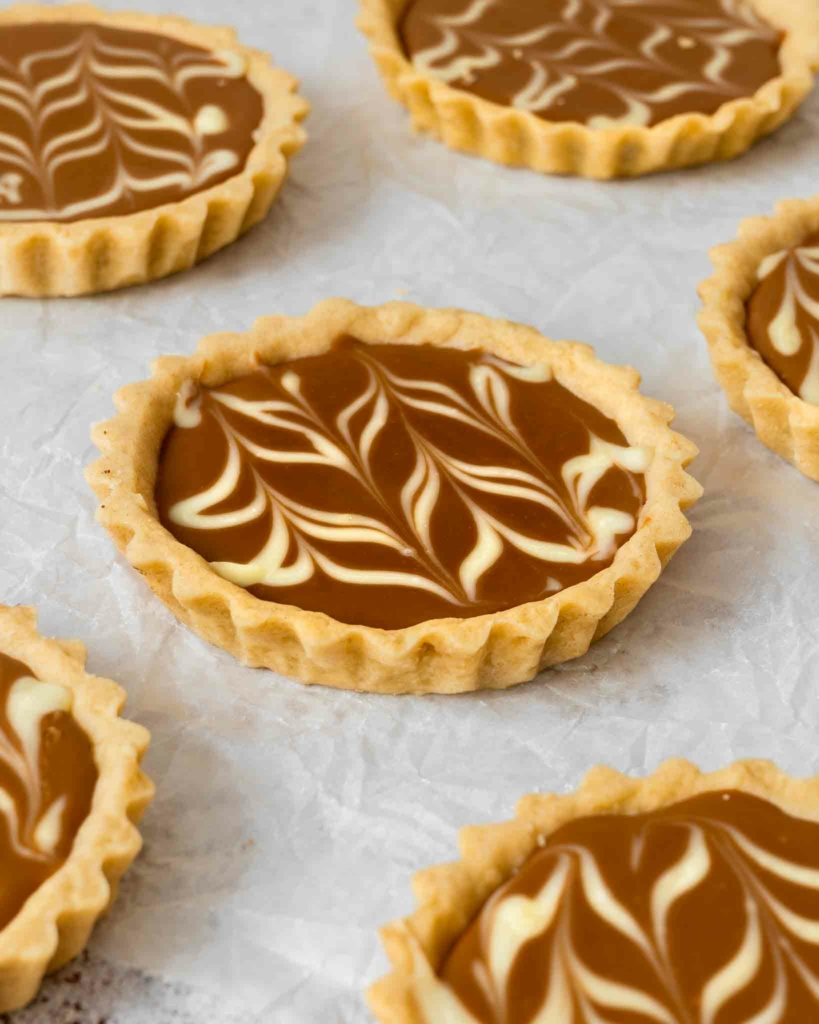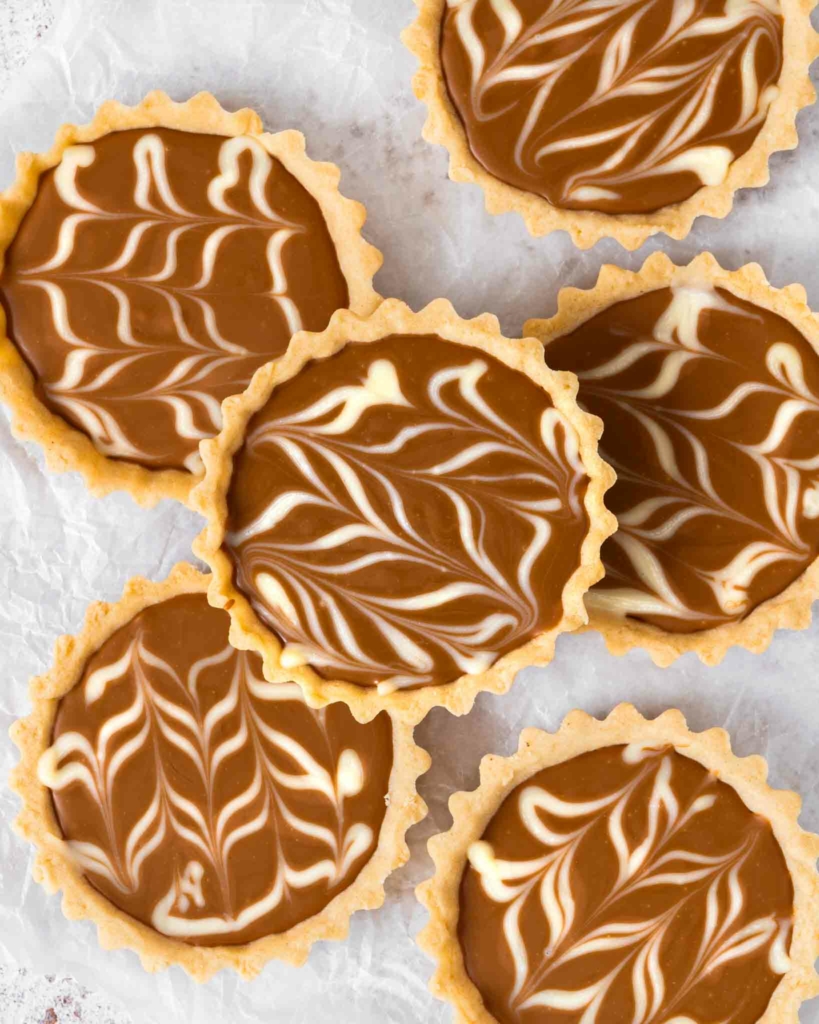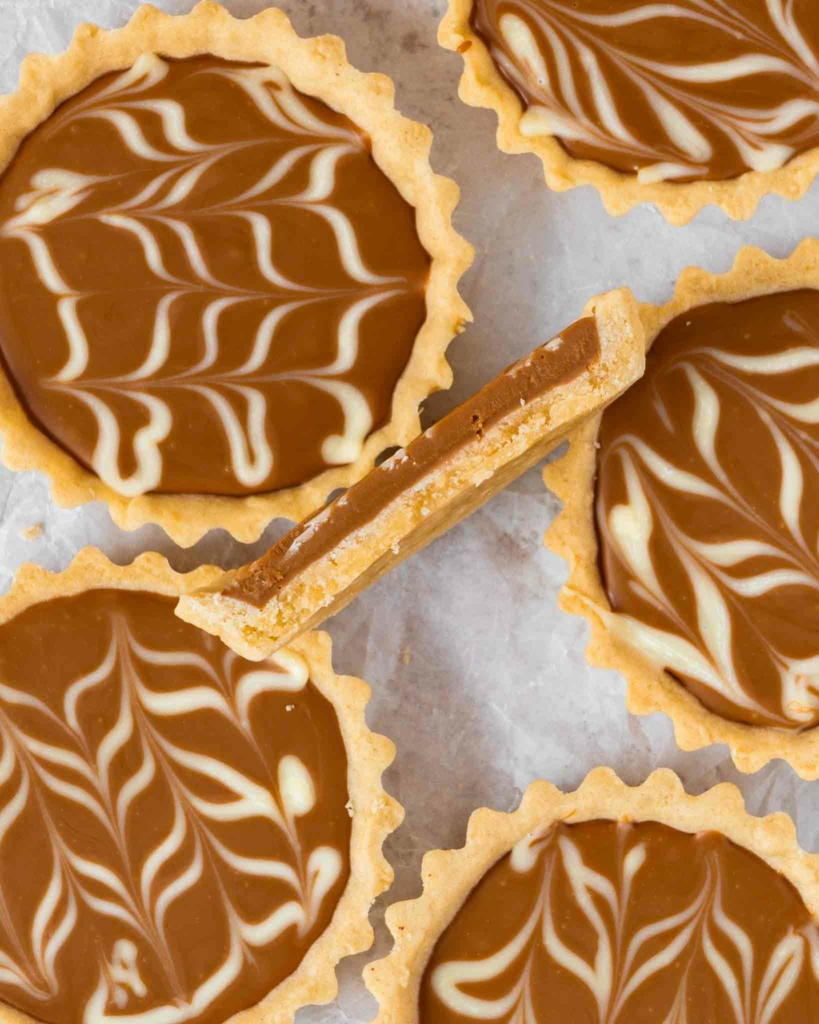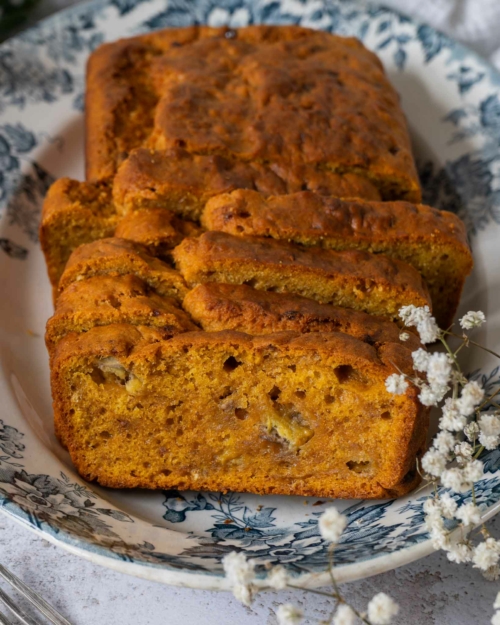Make simple Biscoff Tarts with our crisp, 4-ingredient pastry shells and an easy no-bake Biscoff filling. Marbled with dairy free white chocolate, these pretty vegan tartlets make the perfect individual dessert.
These easy Biscoff Tarts combine buttery, melt-in-the-mouth pastry with a sweet, cinnamon, cookie-butter filling. Requiring just 6 ingredients, these Biscoff tartlets are actually rather simple to make. With their pretty marbled white chocolate top, they make the perfect dinner party dessert.
Have you ever made vegan pastry? Whilst it can seem intimidating, making beautiful, crisp pastry that is the perfect base for a sweet tart, is not as complicated as it may seem. I’m walking you through the process, providing important success tips for creating excellent vegan pastry.
The filling for these mini Biscoff Tarts couldn’t get much easier! Warm up Lotus Biscoff Spread and pour it into the pre-baked tart shell, marble melted white chocolate on top (we show you how, it’s very straightforward) and then let it set in the fridge. Voila! Picture perfect tartlets, ready to serve.
Quick Links:
- The written recipe
- Why you’ll love this recipe
- Success tips
- Step by step instructions with photos
- FAQs
- Other deliciously sweet dessert recipes like this one
Why you’ll love these Biscoff Tarts
Just 6 ingredients. You’ll need flour, icing sugar, ground almonds and dairy free butter to make the pastry (plus a dash of water). To fill each Lotus Biscoff Tart, you’ll just need warmed Biscoff spread and melted vegan white chocolate. That’s it!
Simple to make but look rather fancy! We use a food processor to make the pastry in two easy steps and, once baked, the tarts are filled with warmed Biscoff spread. The white chocolate marbling isn’t essential but it’s an easy trick to making your tartlets look like they’ve just stepped out of a bakery!
They’re crisp, buttery, sweet and delicious! One of our taste testers stopped me in the street to tell me again how much he enjoyed his Lotus Biscoff Tart! Biscoff spread is a glorious creation, so our only job really was to create a beautifully crisp and buttery pastry to go with it, which we think we have done (and hope you think so too).
They can be prepped in advance. If you’ve got a dinner party coming up, you can make these Biscoff tartlets in advance to save work on the day. You can either prep the pastry the day before and keep it in the fridge until you’re ready to bake it, or you can make the whole tartlets the day before and keep them in the fridge until you’re ready to serve. Phew!
Additions and alternatives. If you want to get extra fancy, you could make a double-layered tart by adding a layer of dark chocolate ganache to make a Biscoff Chocolate Tart with a chocolate filling, or a layer of vegan caramel (get our easy caramel recipe here) to create the ultimate treat! Happy baking!
Success Tips
Follow these important success tips when making this Biscoff tarts recipe:
- Keep the pastry ingredients cold. A crucial success tip when making shortcrust pastry is to keep the ingredients cold (and the pastry dough once made). Use cold vegan butter and ice cold water when making the pastry, and chill the pastry between steps to prevent the butter from leaking out during baking.
- Don’t overwork the pastry. Don’t handle the pastry too much (e.g. by kneading it for more than a few seconds) because this can cause your finished baked pastry to be tough.
- Bake until lightly golden. Baking time can vary depending on the oven and the size of the tart pan. Bake for 15 minutes before checking the pastry – if it is dry to the touch and lightly golden it’s likely ready. If the pastry does not feel dry and/or is still pale, bake for another 2-3 minutes before checking again.
- Did you underbake? Follow this tip! If you take the baked pastry cases out of the oven and after a few minutes the base starts to look a little dark or damp then they’re probably underbaked. They need to be dry to the touch and a light golden colour. Don’t panic though! If you think you’ve taken them out of the oven too soon, just preheat the oven again and pop them back in again for a few minutes so they can finish cooking.
How to make these vegan Biscoff Tarts
Ingredients
Here are the ingredients you’ll need to make this Biscoff mini tart recipe:
Plain flour. Also called all purpose flour, or you can use pastry flour.
Icing sugar. Also called powdered sugar. You should not substitute for caster, granulated or brown sugar.
Ground almonds. Used to add a delicate crispness to the pastry.
Dairy-free butter. Use the block kind that you can cut into cubes rather than a spreadable variety. Make sure it’s cold when you use it.
Water. Make sure your water is as cold as possible!
Lotus Biscoff spread. Opt for the smooth variety.
Vegan White Chocolate. For decoration. You could also try melted dark chocolate if you prefer or add Lotus biscuits on top (or another brand of speculoos cookies).
Equipment
You’ll need a food processor, rolling pin and mini non-stick tart tins (its a good idea to pick tins with a removable bottom) to make these easy Biscoff tarts, along with a saucepan and heat proof bowl for making the topping.
Steps
Make sure to head to the recipe card below for the full recipe and instructions on how to make these Lotus Biscoff Tartlets!
Gather together your ingredients and weigh them out. We recommend using electronic scales rather than measuring cups. Cube the butter but keep it chilled until you’re ready to use it.
Add the flour, butter, icing sugar and ground almonds to the bowl of a food processor. Blend for a few seconds until the mixture resembles fine crumbs.
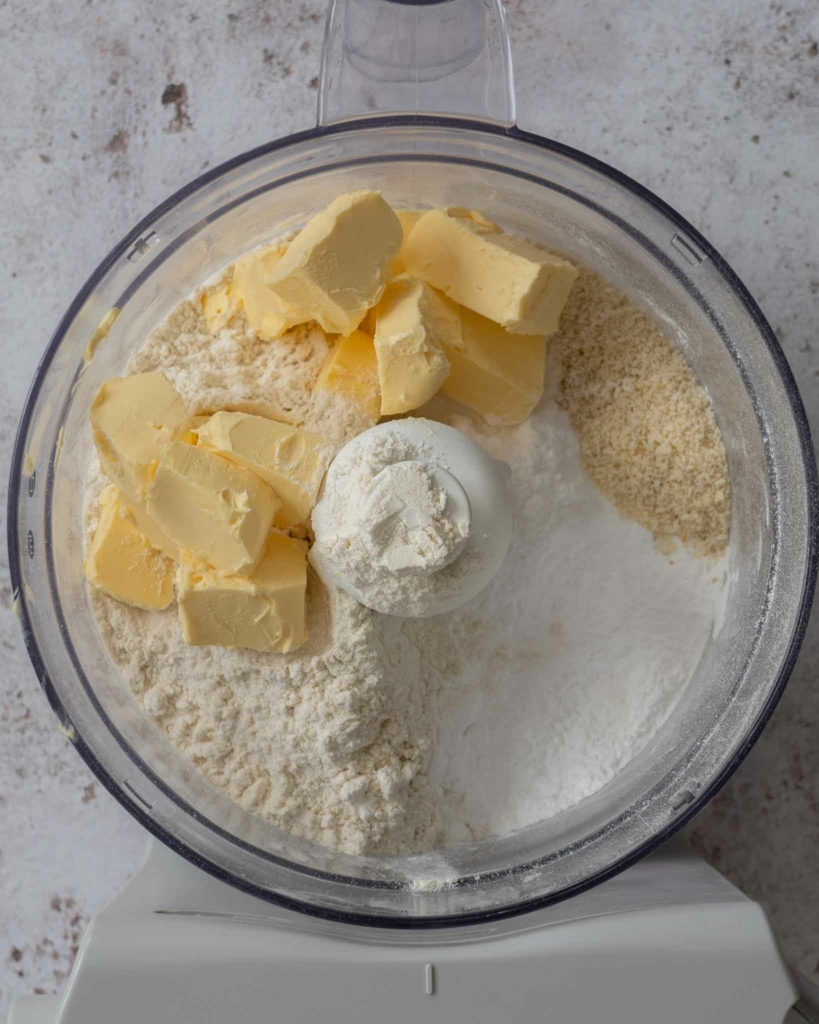
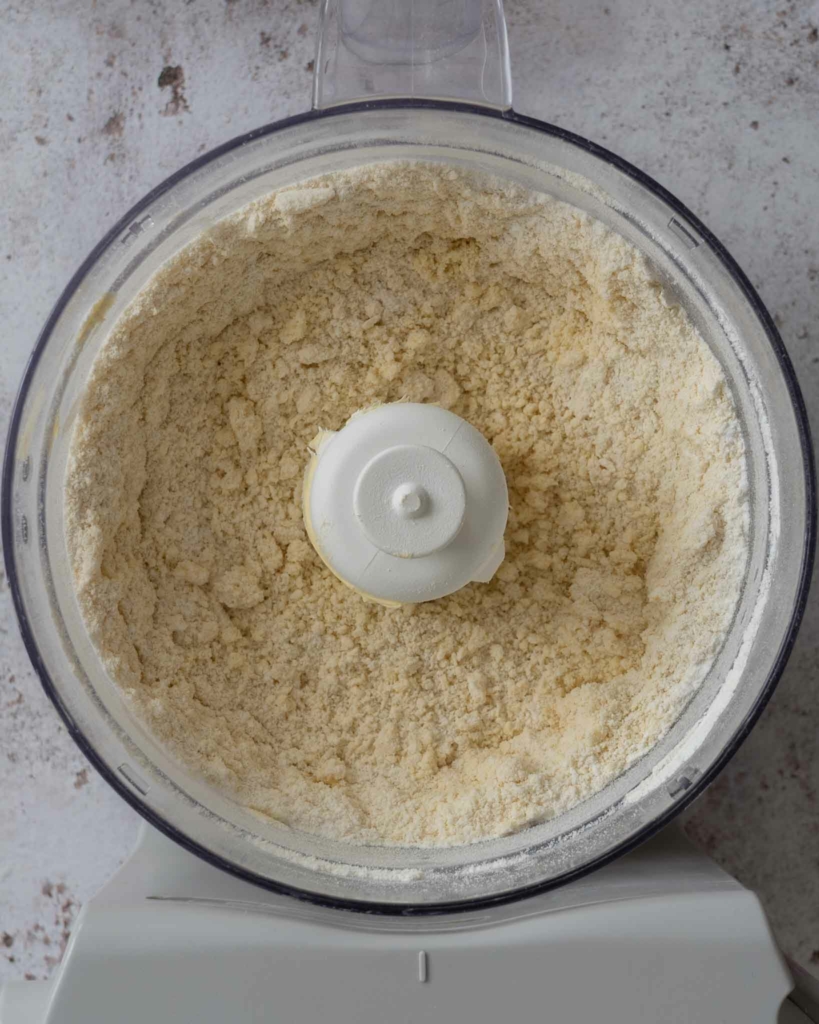
Add 1 tbsp water and blend again for a few seconds. The mixture should come together when squeezed, and no longer be crumbly. If it is crumbling, add 1/2 tsp water and blend again.
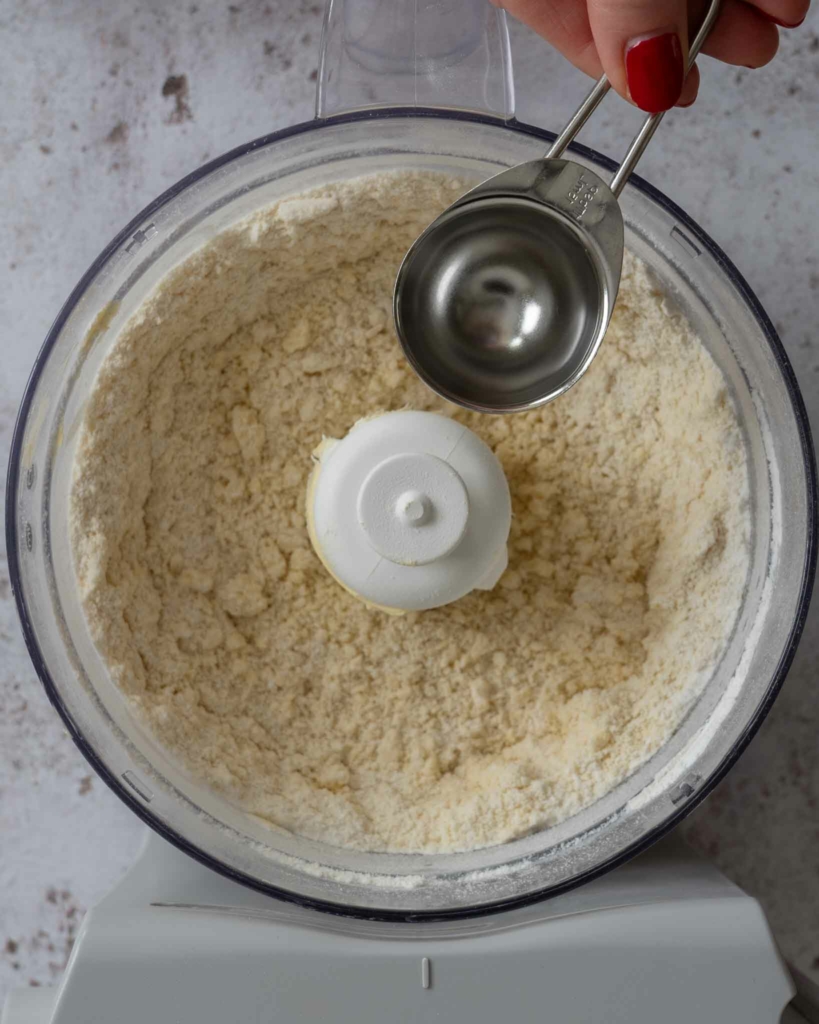

Bring the dough into a ball. Wrap the pastry dough in eco cling film and chill it in the refrigerator for at least 1 hour or the freezer for 30 minutes.
Note: Don’t freeze the pastry for more than 30 minutes if you plan to use it today. You can transfer it from the freezer to the fridge after 30 minutes if you’re not quite ready to roll it out.
Note: The pastry can be stored in the fridge for up to 2 days (wrapped tightly in eco cling film and ideally in an airtight container too).
Roll the pastry out on a lightly floured surface to around 3mm thick (1/4cm or 1/8”).
Cut out a piece of pastry dough that is 1-2cm larger than one of your tart tins.

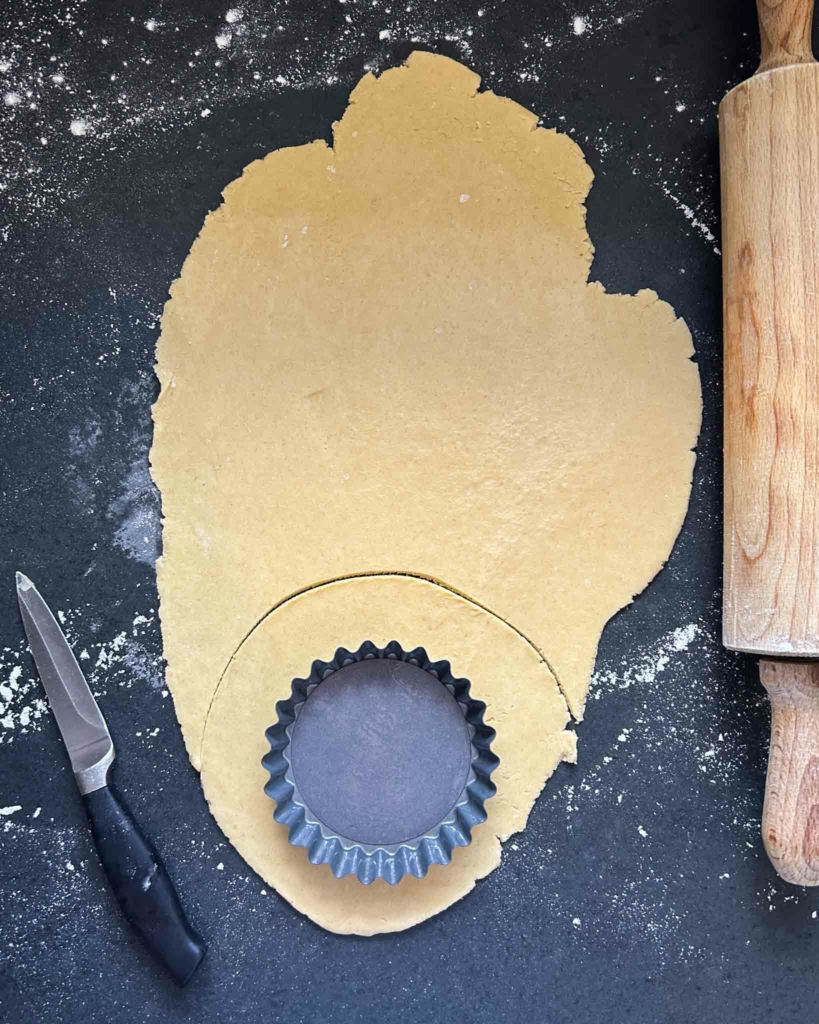
Transfer the pastry to the tart tin and gently press it into place. You can use a small ball of pastry to press it into the corners of the tin.
Cut off any excess with a sharp knife. Re-roll any leftover pastry to line the additional tart tins.
Lightly prick the base of the pastry with a fork or knife tip (this stops it from puffing up too much in the oven).
Place the tart tins on a baking tray in the fridge to chill for 10 minutes whilst you preheat the oven (don’t skip this chilling time).
Bake for 15-20 minutes at 150°C (170°C conventional / 325°F / gas mark 3) until the pastry is dry to the touch and lightly golden. Set the pastry cases aside to cool in the tins.
Note: If you think you have underbaked the pastry, preheat the oven again and pop them back in for 3 minutes before checking again.
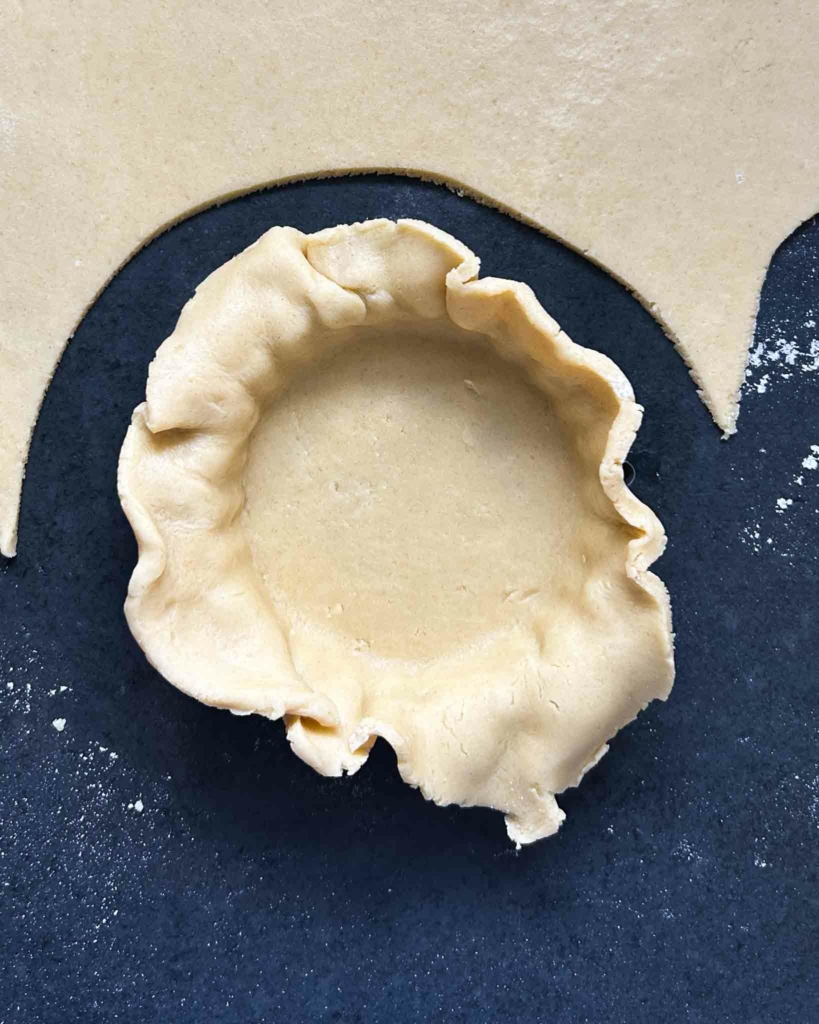
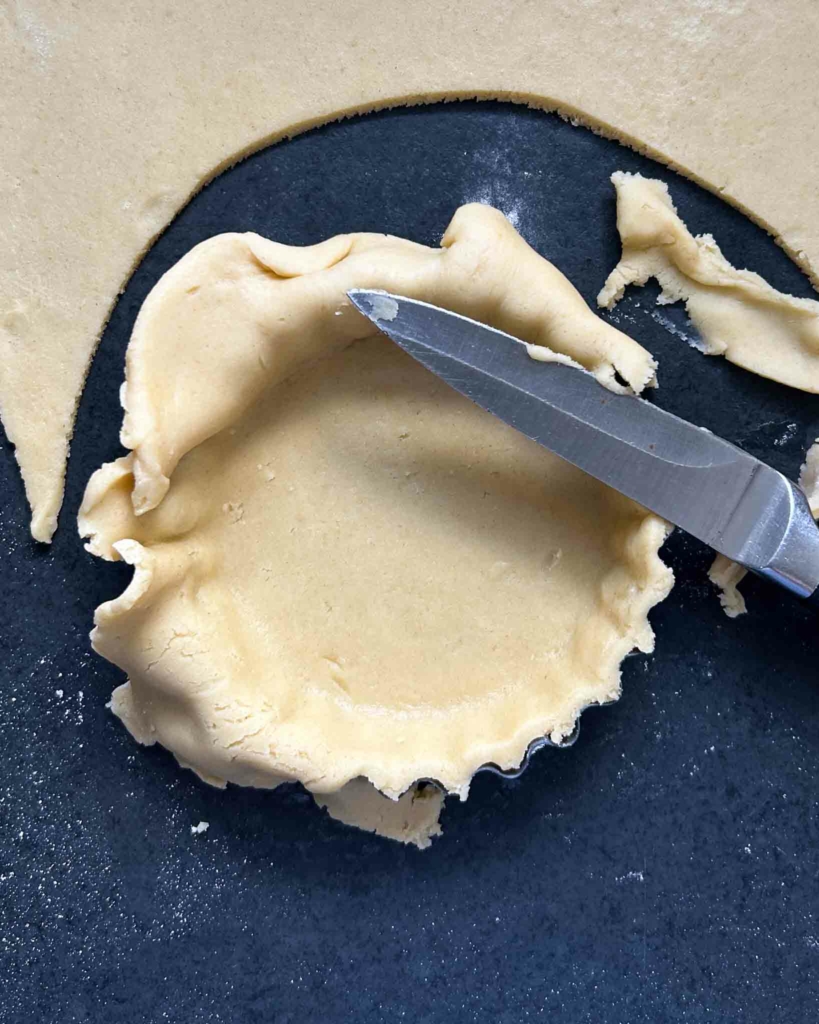
Add the smooth Lotus Biscoff spread (cookie butter) to a saucepan over medium heat and warm it through until it is a pourable consistency. Pour the melted cookie butter into your pre-baked vegan tart shells.
Immediately melt the vegan white chocolate by placing pieces of chocolate in a heatproof bowl set over a small saucepan of simmering water (without the bottom of the bowl touching the water). Carefully transfer the melted chocolate to a piping bag with a small piping nozzle attached.
Draw lines of melted chocolate onto the surface of the tart, top to bottom (you’ll need to do this before the Biscoff spread has set).


Take a clean skewer/toothpick and lightly drag it across the surface of the tart (left to right) to create a pattern. Repeat in even spacing until you’ve created a pattern over the entire tart. This is such a great option for adding decoration to tarts as it’s quick and easy to do but adds a professional finish.
Place the tartlets in the fridge to set for 2-3 hours.
Remove the tart tins once the pastry is cool (you can either do this before you fill the tart shells or once the filling is completely cool).
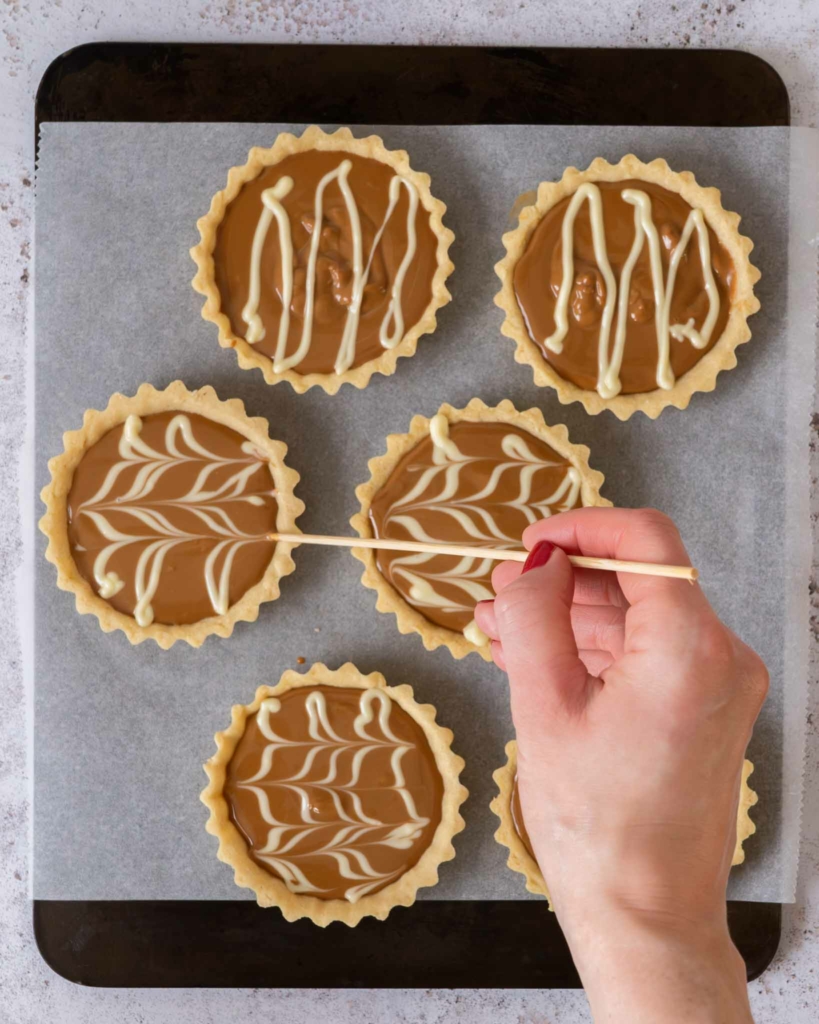

FAQs
Why put fork holes in pie crust?
Using a fork or knife to prick the base of a pie crust before baking helps to prevent the pastry from rising too much and doming, which leaves less space for filling.
An alternative to this method is to blind bake the tart shells using dried beans/rice, which we describe below.
What is ‘blind baking’ tart shells?
Blind baking tart shells involves baking the pastry before adding the filling, which we recommend when making tart shells.
One method is to put the pastry filled tart-tins into the oven, without anything in them. As long as you lightly prick the base of the pastry with a knife/fork before baking, the result should be fairly neat although you may see a little bit of doming in the oven and some shrinkage around the edges.
Another method, if you’re looking for a particularly neat finish, is to line the unbaked pastry with parchment paper and fill the shells with pie weights, dried beans or rice. This weighs down the pastry whilst it bakes, preventing it from rising and resulting in a neater finish.
You should remove the parchment paper and beans/rice a few minutes before the end of baking, to allow time for the pastry to finish baking and turn lightly golden. Blind baking using this method of parchment paper and dried beans will likely add a couple of minutes onto the bake time.
Can I make this pastry in advance?
If you’re not ready to bake your pastry just yet, you can wrap the dough up and either pop it in the fridge for up to 2 days, or freeze it for up to a month. Just defrost it fully in the fridge for 24 hours before use.
What is the Biscoff flavour?
The Biscoff flavour is sweet, warm and lightly spiced with hints of cinnamon and caramel.
Biscoff spread is a smooth, spreadable cookie butter, with a consistency similar to peanut butter, that tastes just like the original Lotus Biscoff biscuits.
Can I melt Biscoff spread?
Yes! The easiest way is to empty the jar of Biscoff spread into a saucepan and warm it gently on the hob over low heat until it is a melted, pourable consistency.
Alternatively add it to a microwavable bowl and microwave in 30 second increments, stirring between increments until it is a pourable consistency.
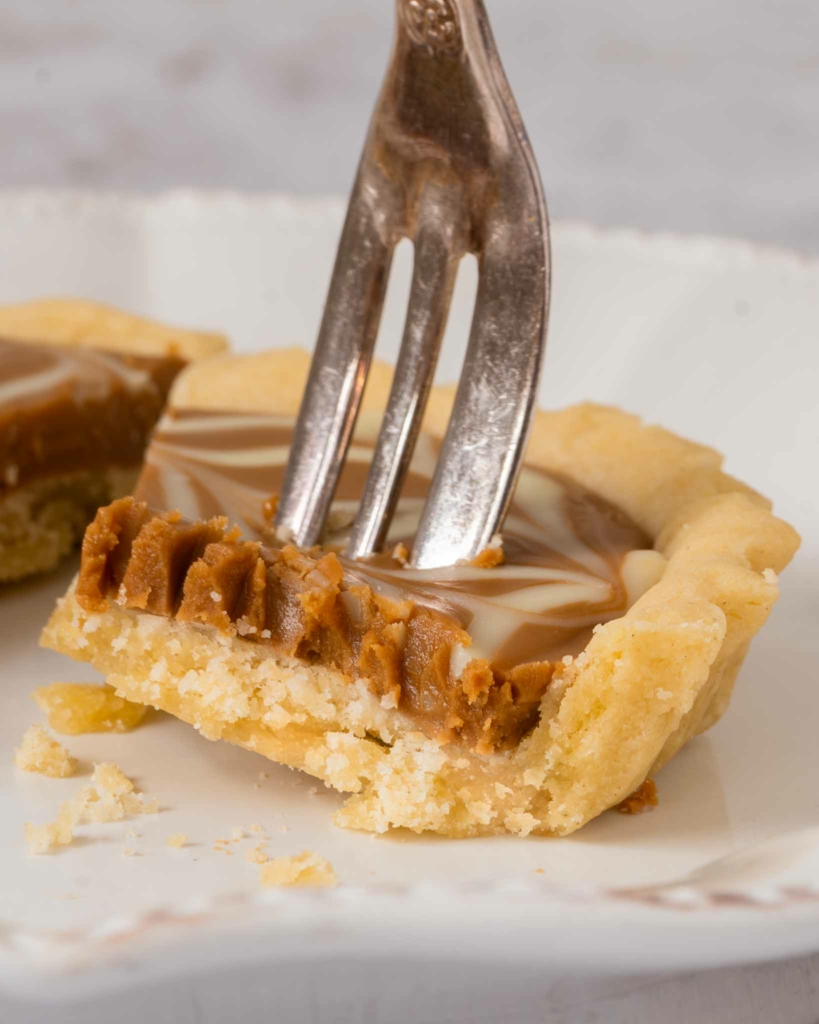
Loved these Biscoff Tarts? Why not try another vegan Biscoff recipe:
I hope you LOVE this recipe for Lotus Biscoff Tarts! Please share this recipe with someone you think will enjoy it too because it’s our goal to encourage as many people as possible to try plant based eating. Please give us a star rating on the recipe card below.
Also, don’t forget to tag @aveganvisit on social media when you make this recipe. I absolutely love seeing your re-creations! Enjoy 🙂 x
If you make this recipe, please leave a comment and star rating below – this provides helpful feedback to both me and other readers. If you want more delicious vegan recipes be sure to subscribe to the A Vegan Visit newsletter. We’d also love for you to join the AVV community on Youtube, Tiktok, Instagram, Pinterest and Facebook.
The Written Recipe:

Lotus Biscoff Tarts (Vegan Cookie Butter Tartlets!)
Ingredients
For the pastry tart shells:
- 160 g plain flour (or pastry flour)
- 50 g icing sugar (or powdered sugar)
- 10 g ground almonds
- 100 g dairy free butter (the block kind, cut into cubes)
- 1 tbsp water (ice cold)
For the filling and decoration:
- 400 g Lotus Biscoff Spread (smooth)
- 70 g vegan white chocolate (broken into pieces)
Instructions
To make the pastry:
- Blitz the ingredients. Add the flour, icing sugar, ground almonds and vegan butter into a food processor and blitz until the mixture resembles breadcrumbs. This should take approximately 20 seconds.160 g plain flour, 50 g icing sugar, 10 g ground almonds, 100 g dairy free butter
- Add the water. Add 1 tbsp cold water to the mixture and blitz again briefly for approximately 10 seconds.Take a small handful of the mixture and squeeze it together in your hand - if the mixture comes together into a ball then it’s ready, if it’s crumbling apart then add another tsp of water and blitz again before testing once more.1 tbsp water
- Chill the pastry. Remove the mixture from the food processor and bring it together into a ball. Press it down to flatten it slightly, wrap it tightly in eco cling film and either refrigerate it for 1 hour or freeze it for 30 minutes.Note: Chilling the pastry before baking prevents the butter from leaking out during baking.Note: Don't freeze the pastry for more than 30 minutes if you plan to use it today. You can transfer it from the freezer to the fridge after 30 minutes if you're not quite ready to roll it out.
- Prepare to roll out the pastry. Once the pastry has been chilled, transfer the dough to a lightly floured surface. Knead the dough briefly for a couple of seconds to make it easier to roll out.
- Roll out the dough. Lightly dust a rolling pin with flour and then roll the pastry dough out to around 3mm thick (1/4 cm or 1/8"). If you roll the pastry thinner than this then it is more likely to tear, if you roll the pastry thicker than this it may not cook through properly.
- Prepare the baking tins. Spray a light coating of spray oil onto non-stick tartlet tins (with removable bases) to prevent the pastry from sticking and to make it easier to remove the tart shells from the tins once baked.Note: We used six round 9cm (3.5”) tartlet tins with removable bases.
- Transfer the dough. Roughly cut out a piece of pastry dough that is 1-2cm larger than one of your tart tins. Transfer this piece of dough to the tart tin and gently press it down into the tin. Trim off any excess with a sharp knife.Note: If you have any mishaps along the way, don’t worry, this pastry is forgiving - just patch it up as necessary, using spare pastry to fill any holes. Use a small piece of rolled-up pastry to gently press the pastry into the tart tin.
- Repeat. Repeat this process with the remaining tart tins, re-rolling remaining pastry as necessary until it has all been used.
- Chill the pastry. Place all of the tart tins onto a baking tray and then lightly prick the base of the pastry cases with a fork . Place the tray into the fridge to chill for 10 minutes whilst you preheat the oven.
- Bake. Preheat the oven to 150°C fan (170°C conventional / 325°F / gas mark 3). Place the pastry cases into the oven to bake for around 15 minutes. Check the pastry cases - if the base feels dry to the touch and the pastry has started to pick up a bit of a golden colour then they are likely ready. If the pastry does not feel dry and is still pale, bake for another 2-3 minutes before checking again.Note: Baking time can vary depending on the oven and the size of the tart tins being used.Note: The pastry can puff up a little in the oven, which isn’t too much of an issue since we plan to fill the tart shells. However, if you would prefer an extra neat finish, line the unbaked pastry cases with parchment paper and fill them with dried beans or rice. Bake for 15 minutes before removing the parchment and dried beans/rice. Continue baking for 3-5 minutes or until the pastry is lightly golden and dry to the touch.
- Storing the pastry. If you’re not ready to bake your pastry just yet, you can wrap the dough up and either pop it in the fridge for up to 2 days, or freeze it for up to a month. Just defrost it fully in the fridge for 24 hours before use.
To fill and decorate the tart shells:
- Melt the Biscoff spread. Add the Lotus Biscoff spread to a saucepan over medium heat and warm it through until it is a pourable consistency. Pour it into your pre-baked vegan tart shells.400 g Lotus Biscoff Spread
- Melt the white chocolate. Immediately melt the vegan white chocolate by placing pieces of chocolate in a bowl set over a small saucepan of simmering water (without the bottom of the bowl touching the water).70 g vegan white chocolate
- Decorate the tarts. Carefully transfer the melted chocolate to a piping bag with a small piping nozzle attached. Draw lines of melted chocolate onto the surface of the tart, top to bottom (you'll need to do this before the Biscoff spread has set).Take a clean skewer/toothpick and lightly drag it across the surface of the tart (left to right) to create a pattern. Repeat in even spacing until you've created a pattern over the entire tart (see the process photos for a visual demonstration).
- Chill the tarts. Place the tartlets in the fridge to set for 2-3 hours.
- Remove the tart tins once the pastry is cool (you can either do this before you fill the tart shells or once the filling is completely cool).

